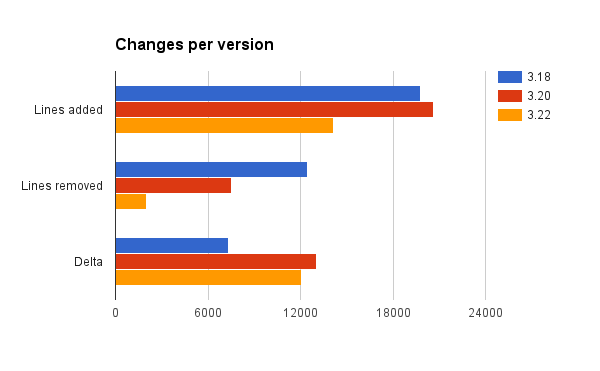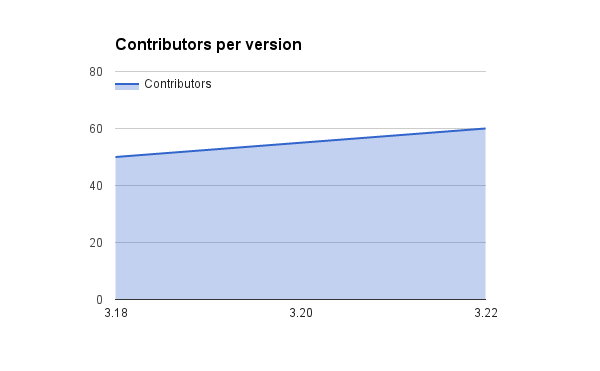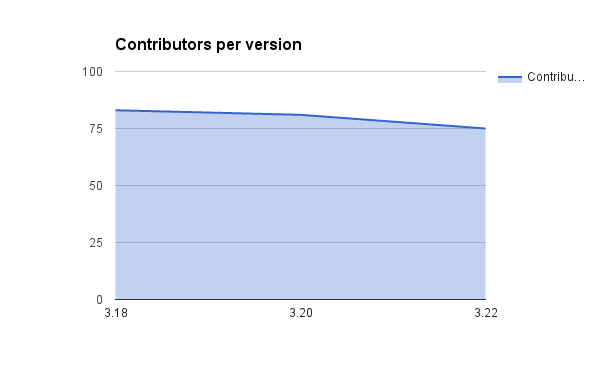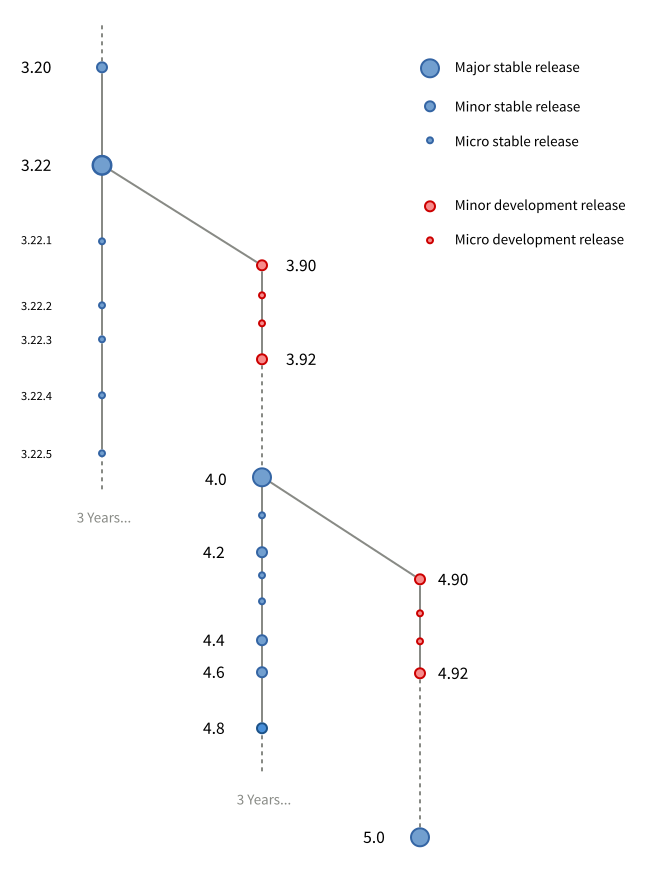Now that GTK+ 3.22.0 and GLib 2.50.0 have been released, it’s time to look back at this development cycle and see the contributions from people and companies that made these releases possible.
Activity
During the 3.22 development cycle, GLib saw a total of 14119 lines added, 2031 removed, for a net gain of 12088 lines:
 GTK+, instead, saw a total of 46581 lines added, 19163 removed, for a net gain of 27418 lines:
GTK+, instead, saw a total of 46581 lines added, 19163 removed, for a net gain of 27418 lines:
The statistics do not include translations.
Contributors
GLib
GLib saw contributions from 60 individuals:
The trend for contributors in GLib in increasing, even if the size of changes has decreasing.
| Developers with the most changesets | ||
|---|---|---|
| Matthias Clasen | 60 | 24.7% |
| Philip Withnall | 44 | 18.1% |
| Chun-wei Fan | 18 | 7.4% |
| Mario Sanchez Prada | 10 | 4.1% |
| Allison Lortie | 7 | 2.9% |
| Ruslan Izhbulatov | 7 | 2.9% |
| Emmanuele Bassi | 6 | 2.5% |
| Krzesimir Nowak | 6 | 2.5% |
| Jonh Wendell | 5 | 2.1% |
| Cosimo Cecchi | 5 | 2.1% |
| Simon McVittie | 4 | 1.6% |
| Ondrej Holy | 4 | 1.6% |
| Christoph Reiter | 4 | 1.6% |
| Rico Tzschichholz | 3 | 1.2% |
| Dan Winship | 3 | 1.2% |
| Aurélien Zanelli | 3 | 1.2% |
| Kjell Ahlstedt | 2 | 0.8% |
| Piotr Drąg | 2 | 0.8% |
| Colin Walters | 2 | 0.8% |
| Emilio Pozuelo Monfort | 2 | 0.8% |
| Developers with the most changed lines | ||
|---|---|---|
| Matthias Clasen | 7797 | 53.6% |
| Philip Withnall | 2736 | 18.8% |
| Cosimo Cecchi | 767 | 5.3% |
| Chun-wei Fan | 674 | 4.6% |
| Mario Sanchez Prada | 418 | 2.9% |
| Allison Lortie | 365 | 2.5% |
| Christoph Reiter | 319 | 2.2% |
| Krzesimir Nowak | 220 | 1.5% |
| Jonh Wendell | 178 | 1.2% |
| Ruslan Izhbulatov | 163 | 1.1% |
| Marc-Antoine Perennou | 142 | 1.0% |
| Emmanuele Bassi | 104 | 0.7% |
| Tim-Philipp Müller | 81 | 0.6% |
| Benjamin Otte | 79 | 0.5% |
| Ondrej Holy | 48 | 0.3% |
| Giovanni Campagna | 43 | 0.3% |
| Jeremy Whiting | 34 | 0.2% |
| Debarshi Ray | 33 | 0.2% |
| Stephan Bergmann | 32 | 0.2% |
| Christian Persch | 30 | 0.2% |
Matthias Clasen and Philip Withnall have been the biggest contributors, this cycle. Matthias worked on the portals implementation for allowing sandboxed applications to access system services; Philip worked on the new structured logging API.
GTK+
GTK+ saw contributions from 75 developers:
The number of contributors is trending downwards, and given that the amount of changes has also reduced, it’s likely a reflection on the overall stabilization process towards the 3.22 long term release.
| Developers with the most changesets | ||
|---|---|---|
| Matthias Clasen | 369 | 37.3% |
| Lapo Calamandrei | 73 | 7.4% |
| Carlos Garnacho | 69 | 7.0% |
| Timm Bäder | 67 | 6.8% |
| Emmanuele Bassi | 60 | 6.1% |
| Ruslan Izhbulatov | 30 | 3.0% |
| Jonas Ådahl | 28 | 2.8% |
| Benjamin Otte | 25 | 2.5% |
| Olivier Fourdan | 21 | 2.1% |
| Matt Watson | 21 | 2.1% |
| Sébastien Wilmet | 18 | 1.8% |
| Chun-wei Fan | 13 | 1.3% |
| Andreas Pokorny | 12 | 1.2% |
| Georges Basile Stavracas Neto | 12 | 1.2% |
| Christian Hergert | 12 | 1.2% |
| Piotr Drąg | 11 | 1.1% |
| Tristan Van Berkom | 11 | 1.1% |
| Ray Strode | 10 | 1.0% |
| Stephen Chandler Paul | 9 | 0.9% |
| William Hua | 8 | 0.8% |
| Developers with the most changed lines | ||
|---|---|---|
| Matthias Clasen | 14378 | 28.2% |
| William Hua | 6212 | 12.2% |
| Ruslan Izhbulatov | 5222 | 10.2% |
| Lapo Calamandrei | 4383 | 8.6% |
| Carlos Garnacho | 3510 | 6.9% |
| Emmanuele Bassi | 1947 | 3.8% |
| Matt Watson | 1811 | 3.6% |
| Georges Basile Stavracas Neto | 1805 | 3.5% |
| Jonas Ådahl | 1647 | 3.2% |
| Chun-wei Fan | 1195 | 2.3% |
| Stephen Chandler Paul | 1099 | 2.2% |
| Timm Bäder | 1018 | 2.0% |
| Sébastien Wilmet | 865 | 1.7% |
| Benjamin Otte | 793 | 1.6% |
| Javier Jardón | 655 | 1.3% |
| Alexander Larsson | 486 | 1.0% |
| Andreas Pokorny | 358 | 0.7% |
| Tristan Van Berkom | 333 | 0.7% |
| Jakub Steiner | 317 | 0.6% |
| Mohammed Sadiq | 298 | 0.6% |
Just like he did in GLib, Matthias worked on implementing support for portals inside GTK+, especially the ones that require user interaction like file selection and printing; Carlos Garnacho worked on the graphic tablets support in Wayland; Jonas Ådahl and Olivier Fourdan worked on the windowing system issues of the Wayland backend; William Hua worked on improving the Mir backend; Ruslan Izhbulatov and Chun-wei Fan worked on the Windows backend, especially with regards to keyboard input; Emmanuele worked on adding GLES support to the GdkGLContext API; Timm Bäder worked on GtkPopover; Matt Watson worked on GtkStack and the internal animation handling.
Affiliations
As usual, much of these changes would not have been possible without the contribution of various companies.
For GLib:
| Top changeset contributors by employer | ||
|---|---|---|
| Red Hat | 84 | 34.6% |
| (Unknown) | 78 | 32.1% |
| Collabora | 43 | 17.7% |
| Endless | 22 | 9.1% |
| Canonical | 12 | 4.9% |
| Centricular | 2 | 0.8% |
| Intel | 2 | 0.8% |
| Employers with the most hackers | ||
|---|---|---|
| (Unknown) | 33 | 52.4% |
| Red Hat | 14 | 22.2% |
| Collabora | 4 | 6.3% |
| Endless | 4 | 6.3% |
| Canonical | 4 | 6.3% |
| Centricular | 2 | 3.2% |
| Intel | 2 | 3.2% |
For GTK+:
| Top changeset contributors by employer | ||
|---|---|---|
| Red Hat | 548 | 55.4% |
| (Unknown) | 333 | 33.7% |
| Endless | 97 | 9.8% |
| Collabora | 6 | 0.6% |
| Canonical | 4 | 0.4% |
| Centricular | 1 | 0.1% |
| Employers with the most hackers | ||
|---|---|---|
| (Unknown) | 49 | 63.6% |
| Red Hat | 16 | 20.8% |
| Endless | 6 | 7.8% |
| Collabora | 3 | 3.9% |
| Canonical | 2 | 2.6% |
| Centricular | 1 | 1.3% |




